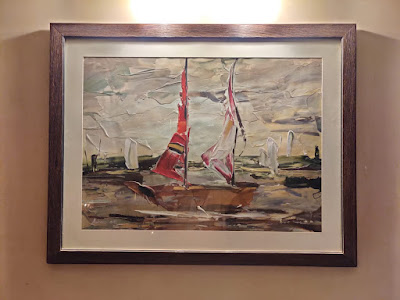It was a typical Sunday dawn, showing all the hints of languor and leisure. I was just snuggling into the couch with a cup of steaming hot tea, listening to the voice of Ronkini Gupta flowing through my music player. Outside my window, the Mumbai skyline looked sombre, the early dawn drizzle drenching everything and the gathered clouds presenting a foggy appearance. Pampered by thoughts of a long day of leisure ahead, I took a sip from my cup.
Turning inside, my half-awake eyes fell on the wall in front. Hanging there was an impasto work, done by applying thick layers of paint in vibrant strokes. The painting portrayed a brown sail boat gliding through the choppy sea. On the background, there were a few more boats with billowing white sails. The pastel shades of mauve, green and grey produced a sky that was much similar to the one outside my window – glum and overcast.
Ever a sucker for anything artistic, I felt a strange pull about the painting, despite having seen it umpteen times already. For all my interest and curiosity, it wasn’t even a realistic work that faithfully brings the scenery before your eyes. There wasn’t single fine line anywhere in the painting, nor was a stretch of same colour. Turbulent waves, blowing winds, swathes of greenery on the seashore and even a hint of a lighthouse – these were all produced with spontaneous strokes. Looking at the painting, I could feel the artist, creative energy pulsating through his veins, flourishing his palette knife across the thick cartridge paper, applying a medley of hues all tangled together, in a show of energy and enthusiasm for his craft.
Looking closely, I found erratic lines, uneven edges and specks of colours that had dripped unexpectedly, all across the landscape. All these could have marred paintings of a formal kind. But here these same things lent a curious charm to the work. The artist seemed to have completed this painting in a single sitting. There was no trace of correction anywhere in the work. There was no application of paint one atop the other, for correction, except the necessary layering of the sky and the sea. That spontaneity is what made the painting unique and special.
My mind turned towards my own amateurish paintings. Ever the one bent on perfection, I work meticulously, trying to correct every line and every layer of paint. Eager to produce the straightest of lines, most perfect of curves and neatest of colours, I end up messing my works by overdoing things. I draw and then redraw the lines. If there is a slightest spot in the canvas where the colour hasn’t reached properly, I apply paint all over again. If a stroke appears to have some uneven edges caused by the odd bristle, I try to hide it by adding another coat of paint there. All such things, while satisfying my quest for perfection, leave a not so aesthetic effect on the final work. Is that my lack of confidence or my excess concern for the perfection of my works, I had never understood. At least not until that morning.
While I was toying around with such thoughts, I found a simile with our own lives and our mistakes too. We all commit mistakes in our lives, most of them unintended and out of ignorance. But how often do we create a bigger mess, trying to ‘correct’ those mistakes! While a simple acceptance of our fault and a sincere apology could set matters straight, we insist on laying upon our mistake layers of excuses and explanation. We try to justify why we did things the way we did. We try to add a veneer of good intentions atop our bad behaviour. End result? Our mistakes assume a greater magnitude for the worse and leave all the parties involved in a poor state of mind.
So, next time I pick up a brush or perform a deed, which results in an unintended mistake, I will try to accept it, apologize and move on, instead of trying to gloss over it with excuses, silly amends and senseless justifications. End of the day, acceptance of such imperfections is what makes human lives unique and beautiful. Not all of us are Michelangelo’s ‘David’, polished and unblemished. But we can all be the clay works from the hands of a skilled artisan – each unlike the others, imperfect with uneven edges and yet, each beautiful in their own unique imperfections!
A.







